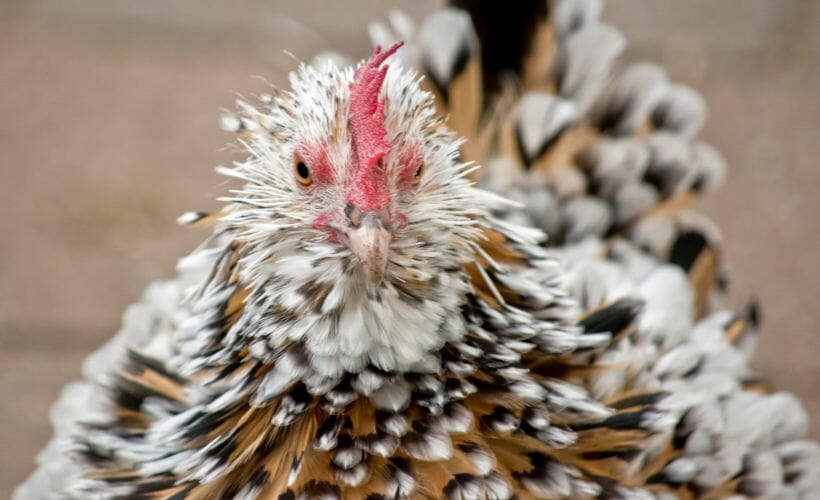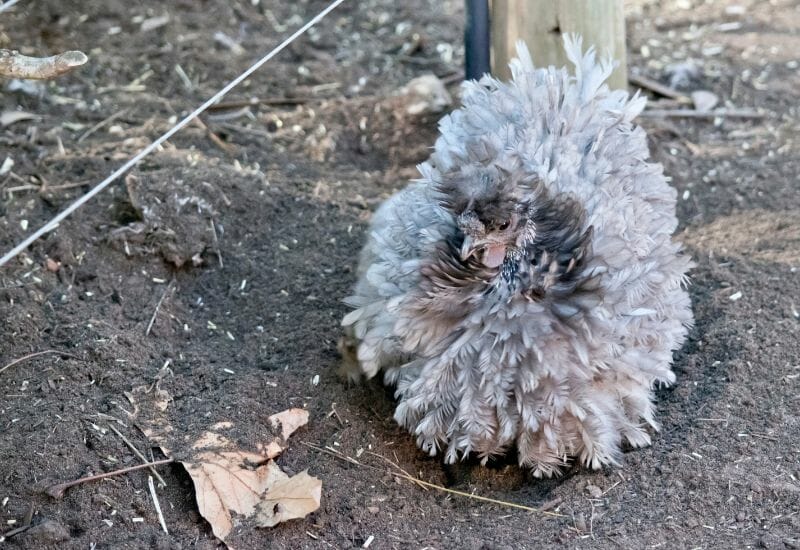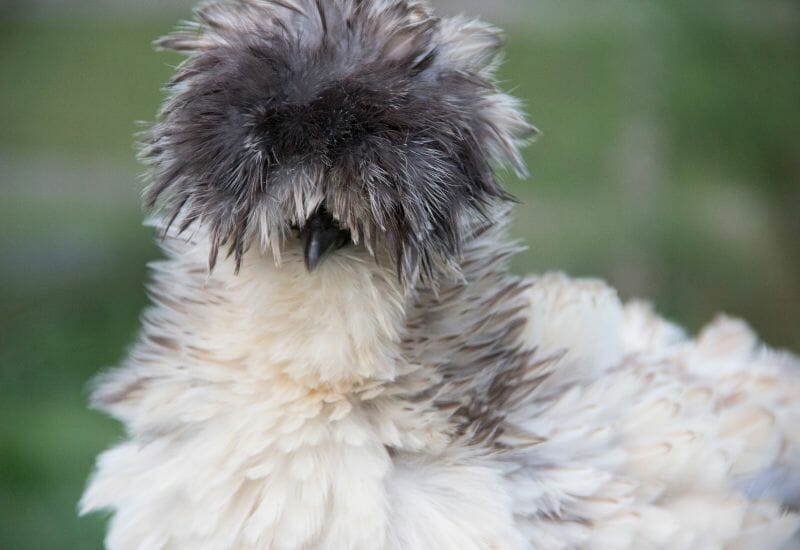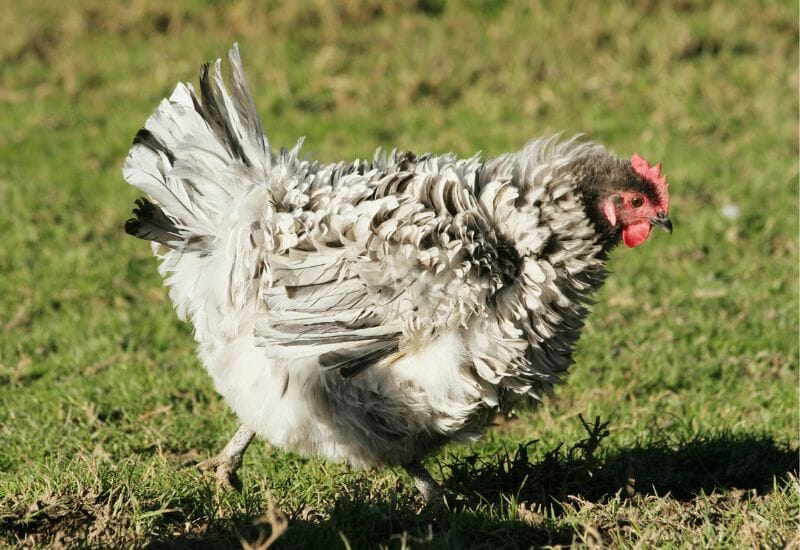Fluffy Magic: The Adorable World of Frizzle Chickens
Learn about the intriguing features and care tips of frizzle chickens with unique curly feathers. Also, discover the special care they need.

I am never short of amazed by the sizes and types of chickens in the world. Before my chicken days, I thought they all consisted of a standard hen in a handful of colors. I thought eggs came in brown or white and nothing more. Boy, was I wrong!
Before I delved into chicken keeping, I researched. Narrowing the chickens I wanted down to the four I had agreed upon would be hard. I wanted a rainbow of hens that laid a rainbow of colored eggs. Mostly I wanted a frizzle.
Prepare to enter a realm of fluffy enchantment and discover the secret world of frizzle chickens. These mesmerizing feathered creatures possess a unique charm guaranteed to captivate and delight. With their signature curly plumage, frizzle chickens make an excellent addition to any flock. You’ll be delighted to witness their playful interactions and amusing antics as they share their coop with other birds.
What Are Frizzle Chickens & What Makes Their Feathers Curl Like That?
One of the most captivating aspects of frizzle chickens lies in their curly feathers, which give them an almost otherworldly appearance. They look sort of like a living feather duster. These mesmerizing feathers cascade in delicate waves, creating an enchanting spectacle that will catch the eye of anyone lucky enough to encounter these unique creatures.
The History of Frizzles
The frizzle is not a new breed. The endearing frizzle chicken has been around for centuries – first recorded in the 1600s! Charles Darwin even mentioned them in his writings, calling them Caffie Fowl and claiming they were largely found in India. While he never visited India, the frizzle gene seems to have originated in the Far East (possibly from China or the East Indies). It has since been brought to Western countries due to its unique appearance. This gene is especially evident in some breeds – Cochin, Polish, Plymouth rocks, and Japanese bantams.
Interestingly, when crossing a silkie and a frizzle, the result is a sizzle, another cool breed of chicken.
If you’re a chicken keeper looking for something a little out of the ordinary, the frizzle offers a whimsically wavy look for your coop.

What Genes Make Frizzled Feathers?
Frizzling is an incomplete dominant gene that causes chicken feathers to twist and curl up from the body instead of lying flat.
One copy of the gene from either parent is enough to create frizzle chicks. While frizzling can produce unique and beautiful results, responsible breeders will avoid breeding frizzle to frizzle, as this can lead to the much less desirable frazzle, which is characterized by brittle feathers, bald patches, and other physical issues that can cause the chicks to have reduced lifespans. Instead, breeders will breed frizzle to an average hen to get a mix of regular and frizzle chicks, with about 50% of each.
Curled Feathers: The Mesmerizing Appeal of Frizzle Chickens
The frizzle chicken grace and elegance with which they carry themselves. With their heads held high and their feathers flowing in effortless waves, frizzles exude an air of regality. Observing them as they strut around their domain, it’s easy to see why they have become a favorite amongst chicken fanciers.
As mesmerizing as their feathers may be, it’s important to remember that the care of frizzle chickens goes beyond their physical appearance. These delightful creatures require special attention to ensure their optimal health and well-being. From providing a nutritious diet to maintaining a safe and comfortable living environment, their needs must be met to thrive in your backyard flock.
Dietary Needs: Feeding your Frizzle Chickens for Optimal Health
Like any other living creature, frizzle chickens require a nutritious diet to maintain optimal health and well-being.
When feeding your frizzle chickens, a balanced and varied diet is key. These fluffy wonders have a voracious appetite and can consume a surprising amount of food, considering their size. You’ll want to ensure that they have access to high-quality commercial chicken feed specifically formulated for laying hens. Look for a feed that contains a balanced blend of essential nutrients such as protein, vitamins, and minerals to support their overall health and egg production.
Frizzle chickens must have access to fresh water at all times. Hydration is crucial for their health and helps to maintain their body temperature, especially during the hot summer months. Ensure their water source is clean and easily accessible to encourage proper hydration.
While commercial feed forms the basis of their diet, it’s important to supplement it with additional treats and supplements. Frizzle chickens love to forage, so providing them with fresh fruits, vegetables, and leafy greens adds variety to their diet and offers additional nutrients. You can experiment with different treats to see what your frizzle chickens enjoy the most but remember to offer them in moderation to prevent overfeeding and potential health issues.
To support their egg production and overall health, consider adding calcium supplements such as crushed oyster shells or eggshells to their diet. Calcium is essential for strong eggshells and helps prevent deficiencies that can lead to health problems. Provide a separate dish containing these supplements for your frizzle chickens to access.

Shelter Considerations: Creating a Cozy Home for Your Frizzle Friends
When it comes to shelter considerations for frizzle chickens, there are a few key factors to keep in mind. First and foremost, your chicken coop should be spacious enough to accommodate the number of frizzles you have in your flock. Adequate space allows them to move freely, stretch their wings, and engage in natural behaviors without feeling cramped or confined.
In addition to space, ventilation is crucial for a well-designed chicken coop. Like any other breed, frizzle chickens need fresh air flowing through their living quarters to prevent the buildup of moisture, ammonia, and odors that can lead to respiratory issues. Good ventilation also helps regulate the temperature inside the coop during hot summer months or chilly winter nights.
Speaking of weather, insulation is another consideration to ensure your frizzle chickens are comfortable year-round. Proper insulation helps maintain a moderate temperature within the coop, shielding your frizzles from extreme heat or cold. This is especially important for frizzles, as their unique feathering may make them more susceptible to temperature fluctuations than other breeds.
When it comes to flooring, selecting the right material is essential. A solid floor, such as concrete or wood, provides a sturdy foundation that’s easy to clean and maintain. However, adding a layer of soft bedding, like straw or wood shavings, will offer your frizzles a comfortable surface to walk on and help absorb moisture and odors.
Lastly, the overall security of the coop cannot be overlooked. Your frizzles need a predator-proof shelter with strong fencing and secure locks to keep out any unwelcome visitors. Additionally, ensuring no gaps or holes in the coop will prevent potential dangers from entering and causing harm to your flock.

Ensuring Health and Happiness: Vital Care Tips for Frizzle Chickens
Caring for frizzle chickens involves more than providing a safe and comfortable living space. These charming birds require a certain level of attention and care to ensure they thrive in their environment. By following some simple guidelines, you can ensure the health and happiness of your frizzles.
First and foremost, a nutritious diet is crucial for frizzle chickens. These birds thrive on a balanced diet that includes a mix of grains, fruits, vegetables, and high-quality poultry feed. Providing them with ample access to fresh water is important, ensuring they stay hydrated throughout the day.
Maintaining good hygiene practices is another vital aspect of caring for frizzle chickens. Regularly clean their coop, removing soiled bedding, droppings, or debris. This helps prevent the build-up of bacteria and keeps their living environment clean and healthy. Providing a dust bath area, preferably with sand and diatomaceous earth, also allows frizzles to clean themselves and keep their feathers pristine.
Lastly, social interaction and mental stimulation are important for the overall well-being of frizzle chickens. These sociable creatures enjoy the company of their fellow flock members and benefit from regular interaction with humans. Spending time with your frizzles, talking to them, and even gentle petting can help establish a bond and keep them content.
If you’ve found value in this blog post and enjoyed reading it, why not share it with your Pinterest community? Pin the image below and spread the love!


